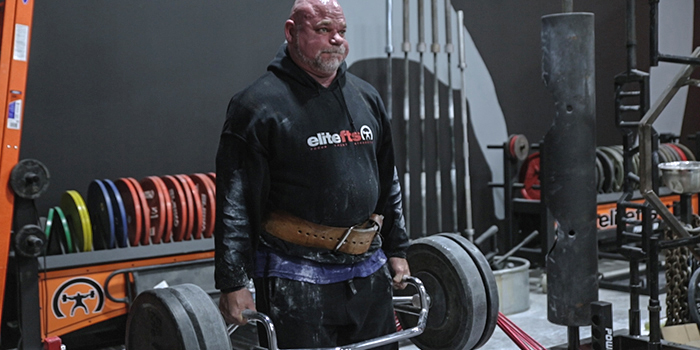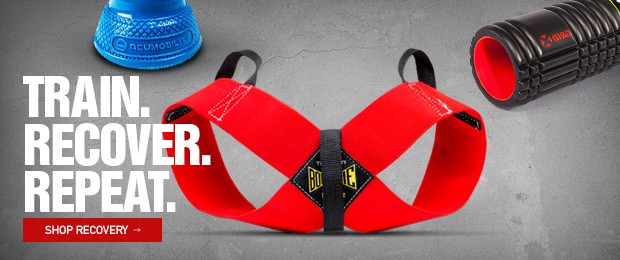
Editor's Note: Fixing Dave Tate is an educational video series intended for demonstration purposes only (acts as a case study specific to Dave Tate). It is not intended to medically diagnose, treat, or manage symptoms. If you are in pain, please consult a licensed healthcare professional.
In the previous installment of the Fixing Dave Tate series, Dr. Rusin and Dave broke down the lower body max effort and dynamic effort training and explained the adjustments that will be made for the third phase. Now it's time to put those ideas to the test. In this video, Dr. Rusin walks Dave through the new dynamic effort lower body training day with the adjustments discussed in the previous video, working through the changes and observing Dave's response. To begin, Dr. Rusin has Dave complete six-phase dynamic warm-up sequence.
Three-Way Thoracic Spine and Rectus Femoris Foam Rolling
Dr. Rusin sees no issues and remarks that Dave’s execution of each part of this exercise looks very good. He reminds that during these foam rolling drills, you want to be relaxed and stay in a parasympathetic state rather than tensing up. The idea is to dull the sympathetic response and get away from pain to move more functionally. Dr. Rusin also says that the thoracic spine is an area that needs constant daily tension and that there’s really no such thing as too much upper back work. He also comments that Dave’s normal movements look much more fluid, and he moves in a positive way during simple acts such as getting onto or off the floor and in position for his exercises.
Half-Kneeling Hip Flexor Positional Stretch
The big emphasis here in the 90-90 position, Dr. Rusin points out, is dominating pillar position and being able to authentically move into right hip extension range of motion. The purpose is to get a little out of a lot, and Dave accomplishes this with an oscillatory technique in which he moves in and out of hip extension. Dr. Rusin explains that Dave's execution is effective only because he is disciplined and makes sure the exercise has purpose instead of just going through the motions.
Quadruped Arm-Leg Opposites (Bird Dog)
Dr. Rusin reminds that in this movement you’re looking for reciprocal function of the upper extremity and lower extremity both coming into extension moments. The intermediary position, the core, is what Dave is really trying to work on here, for getting his body to work as a functional unit. Dr. Rusin also points out Dave’s modification to accommodate the condition of his shoulders, which is not a problem because the main purpose of this exercise being used on a lower body training day is the hip extension moment.
Double Banded Glute Bridge
As previously explained, successful execution of this banded exercise means creating more glute activation in an abducted, externally rotated hip position. As an adjustment, Dr. Rusin has Dave attempt to involve more of his shoulders and upper back in this exercise by driving his elbows into the ground in a 45-degree position. This helps the spine remain in neutral and leads to more “true” hip extension. Dr. Rusin also has Dave move his feet slightly closer together and pre-rotate his hips. This decreases the size of the moment arm.
Kettlebell Squat and Romanian Deadlift
In this dual movement, Dave’s execution of each exercise is very similar; according to Dr. Rusin, the Romanian deadlift and the squat don’t look significantly different. To change this, Dr. Rusin suggests that Dave take his stance slightly more outward for the squat and perform it in a more knee-dominant position. This helps set it apart from the RDL, which is with a shoulder-width stance and the toes pointed directly forward. Dr. Rusin remarks that Dave does a very good job of feeding the kettlebell through his legs while keeping the weight on his heels. He also has him slow the tempo down and build more tension.
Split Squat Midrange Iso-Hold
Dr. Rusin reminds that because Dave doesn’t do any jumping or plyometrics, it’s very important that he uses the isometrics to find maximal tension throughout his full body. He makes a minor adjustment in Dave’s positioning, but remarks that Dave has shown massive improvement in this exercise.
With this review of the warm-up movement sequence complete, they move to the actual training session.
The Hamstring Primers
To begin the actual weight training for the upcoming blocks of training, Dave will perform two hamstring movements as primers. One will be a seated variation and one will be a standing or lying variation, but they'll be the same variations twice per week. The purpose of this is to increase blood flow around the knee and lubricate the joint before moving to explosive loading. Dr. Rusin has Dave use a tempo and loading that can get him close to failure around rep 15. The goal is to focus on peak contraction, constant tension, long eccentric movements, and smooth movements. While observing, Dr. Rusin reminds Dave to reduce back extension as much as possible to keep the contraction in the intended area rather than letting another muscle group take over.
Dynamic Effort Squat Work
As is always the case with dynamic effort work, Dave is looking for maximal movement velocity under load with this exercise. His setup for this movement is currently eight set of two with 45 seconds of rest between sets, with the goal of building speed endurance; he wants his speed to remain high for all eight sets without fatigue setting in. While Dave squats and Dr. Rusin observes, several key things reveal themselves, including Dave going outside of the program by doing additional reps on his final set, and him ditching his belt because of his difficulty breathing while trying to recover. Dr. Rusin points out that he couldn’t be happier with Dave’s movement pattern and that he has made tremendous progress, despite Dave sometimes going outside of the plan.
Trap Bar Deadlift and Dumbbell Romanian Deadlift
Similar to the squat, the trap bar deadlift is currently being performed against bands in Dave’s program, with a dynamic effort focus for six sets of two. In the first two phases of training, Dave was very successful using these, and the plan was two now alter them to include a slow, controlled eccentric. However, throughout this workout, Dave and Dr. Rusin learn that the slow eccentric feels terrible for Dave. So as an adjustment, Dave will instead add a tempo-based Romanian deadlift, lengthening the hamstrings under a heavy load while holding dumbbells. The goal here is to link-up two of Dave’s strengths: eccentric strength in the lats and eccentric strength in the hamstrings.
This means for his trap bar deadlift he will return to pulling singles (with the option of doubles) for four to six sets while adding the dumbbell Romanian deadlifts. With the Romanian deadlift, Dr. Rusin cues Dave not to move his knees backward as he performs the movement; in fact, in a true hip hinge the knees will be somewhat bent (without moving forward) rather than being excessively straight. Dr. Rusin also encourages Dave to focus more on slowly moving the weight down to really nail the proper motion. They work together to find proper loading for sets of eight reps and work through the nuances of a hip hinge.
Banded Glute Bridge
This final exercise is used as a "pump finisher" programmed as a big rest-pause set. Focused on a controlled motion, Dave does a set to failure, performs deep breathing for 15 seconds, goes to failure again, performs deep breathing for another 15 seconds, and does one final set to failure. On the final rep of the final set, Dave also holds the position for as long as possible.
Dr. Rusin closes the video by discussing the recovery work that Dave performs immediately after each training session, lasting for five to 15 minutes. The goal is to dull the sympathetic response from training and go back into parasympathetic mode. This is something that any type of lifter, athlete, and person can benefit from, Dr. Rusin adds. The goal is to reduce heart rate, respiratory rate, and the global fight-or-flight response, which can easily be accomplished by getting into a fully-supported position (lying on the floor) while utilizing deep breathing (four seconds on the inhale, hold at the top, six to eight seconds on the exhale). As Dave performs his breathing work, Dr. Rusin explains the technique and gives parameters for this type of recovery protocol.
FIXING DAVE TATE SERIES
- Initial Assessment with Dr. John Rusin
- Movement Screening
- Orthopedic Evaluation
- The Three Areas of Focus Discovered During Initial Evaluation
- Observing Dave's Current Training Capabilities
- Programming the Six-Phase Dynamic Warm-up Sequence
- The Dynamic Warm-Up Sequences for Upper Body and Lower Body
- The 10-Week Update Discussion
- Adjustments to Lower Body Training Days for Phase 3









